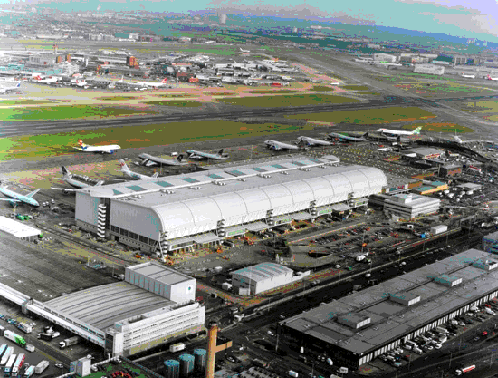Abstr:Wind environment around an airport terminal building
Application Area 4: Civil Construction & HVAC
Application Challenge AC4-01
Abstract
The subject of this Application Challenge is a study of the wind environment around a large airport terminal building (Figure 1). The building is ~300m long and is roughly rectangular in plan, with an aerofoil-shaped roof. It is located near to one of the main runways of the airport. The surrounding area is relatively open, with a few neighbouring buildings with large plan dimensions but of lower heights.
This study relates to an actual civil construction project. A comprehensive wind tunnel study was carried out by BMT on behalf of Atkins to assess the effect of ground level winds on pedestrian comfort, internal ventilation, and cladding structural loading.
Since the building is located near one of the main runways, its influence on the wind environment over the runway and its effect on aircraft landing and take-off also had to be evaluated. This is an unusual requirement for building design, and the main parameters that were assessed were the velocity defect and turbulence enhancement in the wake of the building at various locations along, and over, the runway.
The original aim of this Application Challenge was to include all the wind engineering design aspects mentioned above, and to compare the data obtained in the wind tunnel study against CFD calculations. However, due to a lack of sufficient information on certain boundary conditions (details of building openings and internal geometrical detail) available data on pedestrian comfort, internal ventilation, and cladding structural loading were not comprehensive enough for the purpose of CFD evaluation. The only dataset that was sufficiently self-contained and well-defined for this purpose was that of the wind environment over the runway.
For this reason, and despite the fact that it is an unusual wind engineering application, this Application Challenge focuses exclusively on the wind environment over the runway. Previously unpublished data from the wind tunnel study are provided on the velocity defect and turbulence enhancement in the wake of the building. These are used to evaluate the results of CFD modelling carried out by the University of Southampton.
Relevance to Industrial Sector
Modelling the wind environment associated with proposed or existing buildings is of central importance for the Wind Engineering and the Civil Construction sectors, and the potential market for wind engineering studies around buildings is large ([Ref. 1], [Ref. 2]). In the UK, wind studies are currently carried out for an increasing number of buildings, though only the statutory minimum consideration is given for the majority of smaller buildings. This limitation mainly arises as a result of the relatively high cost associated with such studies, which are typically carried out in the wind tunnel. The cost of a wind tunnel study depends on the cost of constructing a detailed model of the building and its surroundings, and increases with the number of measurement locations and the number or complexity of measurement techniques required. By contrast, CFD simulations provide information on all flow parameters in the entire modeling domain, and can offer more flexibility when exploring a variety of building designs and modifications.
CFD could potentially supersede traditional wind tunnel studies as a more cost-effective and powerful design tool for wind engineering studies, leading to a significant expansion in the demand for such services. However, wind tunnel testing is a mature and trusted experimental methodology, whereas quality and trust in the use of CFD for wind engineering applications is still a contentious issue [Ref. 2].
Contributors: Steve Gilham - Atkins

